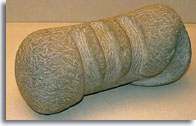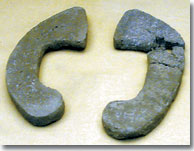| Search and Discovery | |||||||||||||||||||||||||||
|
One key to understanding that improvement is the relation between the jumpers' feet and center of mass. Before the takeoff, an athlete holds the halteres extended backward, then swings them forward. At takeoff, the jumper's arms are extended up and out, and so the center of mass of a weighted jumper is further forward and higher than it would be without halteres. As the jumper prepares to land, the halteres are swung down and backward so that, on landing, the feet of the weighted jumper are more forward of the center of mass than they are for modern, unweighted athletes. Because the initial position and velocity of the center of mass determine its subsequent trajectory, halteres improve the jump distance, provided that their extra weight does not excessively diminish the takeoff speed.
Minetti and Ardigó asked subjects to jump vertically, with and without halteres. The posture and muscle action associated with a vertical jump are very similar to those of a standing long jump, but jumping vertically is a more familiar skill, and one easier to coordinate with swinging weights. Thus, vertical jumps were more practical to test than the horizontal sort. They were also easier to simulate on a computer. The Manchester experiment determined that takeoff speed actually increased by 5-7% when jumpers were loaded with halteres weighing from 2 to 9 kg each. That mass range corresponds well with the range of archaeological specimens, three of which are pictured above. Within the 2-9 kg range, the speed was essentially constant, given experimental uncertainties. The greater takeoff speed achieved by loaded jumpers led to increases in distances beyond those generated by using the halteres to shift the position of the feet relative to the center of mass. As Minetti explains it, halteres can lead to an increased takeoff speed because moderately loaded muscles exert greater force than unloaded muscles, while still contracting at reasonable rates. Thus, loaded muscles can generate increased power. Minetti and Ardigó's experimental results were generally consistent with the results of their computer simulation. In their model, a jumper was built from a shank, a thigh, a trunk, and an elbowless arm. Joints at the knee and shoulder were able to generate torques. The model included physiological measurements relating muscle forces to contraction distances and speeds, and relating joint torques to angular displacements and speeds. When holding a pair of 3-kg halteres, the virtual jumper increased takeoff speed by 2%. Minetti and Ardigó suggest that the simplicity of the model, in particular its lack of elastic structures such as tendons and ligaments, could be responsible for the discrepancies between simulation and experiment.
Steven K. Blau
1. A. E. Minetti, L. P. Ardigó, Nature
420, 141 (2002).
© 2003 American Institute of Physics |
|
Sponsored links
| |||||||||||||||||||||||||
| |||||||||||||||||||||||||||


